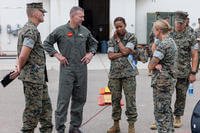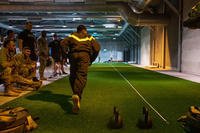Preparing for U.S. Marine Corps boot camp requires a physical fitness level above and beyond that of other regular service branches. The longer running distance and pull-ups alone are the events most people have trouble with when assessing themselves at the beginning of their Marine Corps fitness journey.
Here is a common question from a Marine Corps poolee (recruit) concerning getting in shape to better endure training at Parris Island in South Carolina or Marine Corps Recruit Depot (MCRD), San Diego:
Hey, I'm Alex. I'm 24 years old. I'm a little overweight with low fitness test scores. What is a good timeline for training for Marine Corps Boot Camp? Is it possible to get in good enough shape in 6 months? I need help with pullups and running. Any advice on those? Thanks, Alex
Alex, thanks for choosing to serve. You likely are familiar with the Marine Corps initial strength test (IST) -- pull-ups, plank, 1.5-mile run. You need to perform well on this fitness test, as the test and standards will get tougher once you are at boot camp and beyond. As a poolee, you can choose pull-ups or push-ups (if you cannot do pull-ups), a plank pose, and a 1.5-mile. However, in the "recruit pool," you should start physical training to exceed the minimum standards, especially if you want to make boot camp less of a daily gut check.
To improve your IST and move toward the maximum scores of the Marine Corps physical fitness test, you must do more pull-ups (20+), plank pose (four minutes) and run three miles at a six-minute pace per mile. These scores will place you at the top of the class physically. A good goal is to be close to those recommended numbers as the physical training at Marine Corps boot camp, though progressive, starts at a higher-than-average level.
As you can see, the Marine Corps physical fitness requirements are much higher than other branches' basic training and testing programs. This preparation will require 5-6 days a week of regular training and progressively building up your running. However, if overweight, you should first consider running every other day until you get to your desired weight. Bike or do another nonimpact cardio exercise on the days in-between. The added impact can hinder you with shin splints, foot pain, knee pain and other typical running overuse injuries seen in military training.
Related running articles:
Your pull-ups will improve as you get stronger at pulling and lose weight. If you do pull-ups three times a week (every other day) and build up the daily volume each week, you can see a remarkable difference in your pull-up scores in 4-6 weeks. Try these classic PFT workouts (pyramid, superset, max-rep set).
On the days between these upper-body days, you can add leg days to help you build the strength and muscle stamina to handle rucking (carrying weight in a backpack). Now, you have a system to train for the fitness tests and the following training soon. Make sure you prepare and realize now that boot camp is not the time and place to get into shape. The Marines will get you into Marine Corps shape during this training, but you need to be at an above-average level of fitness so they can work with you and not break you in the process.
References:
Want to Learn More About Military Life?
Whether you're thinking of joining the military, looking for fitness and basic training tips, or keeping up with military life and benefits, Military.com has you covered. Subscribe to Military.com to have military news, updates and resources delivered directly to your inbox.


















